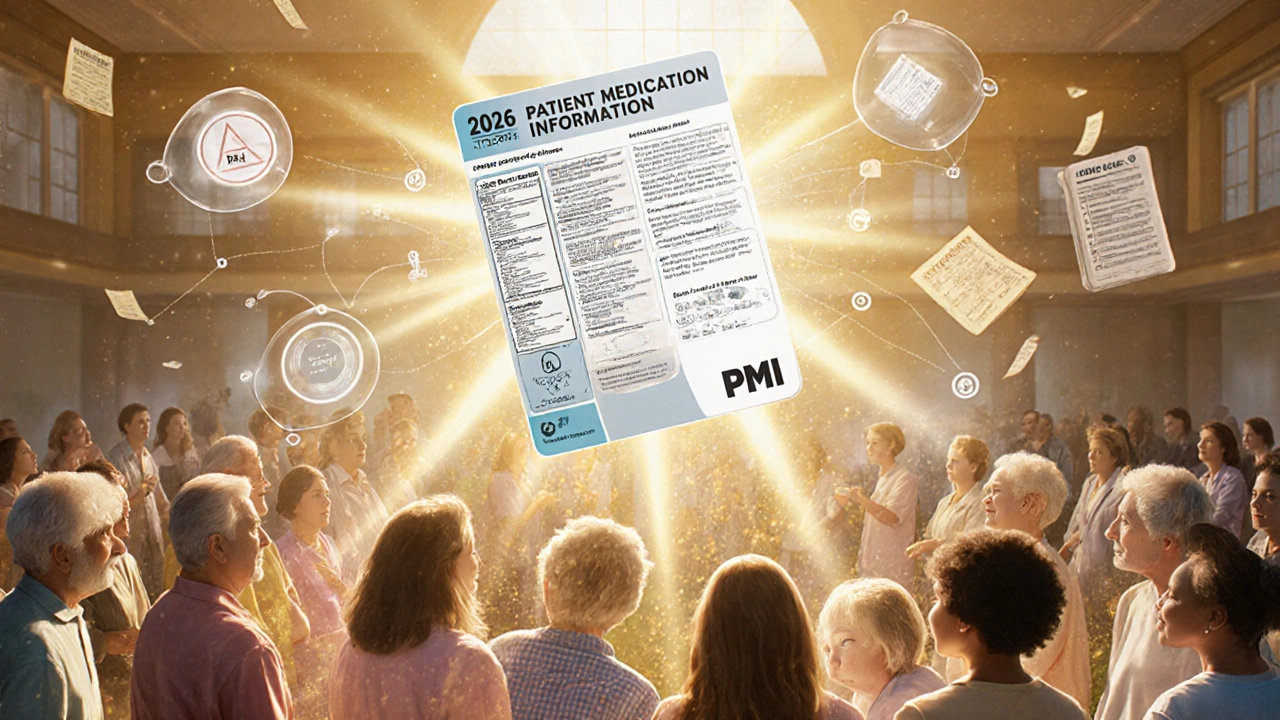Side Effect Information Finder
- Visit FDA Medication Guides for your Medication Guide
- Check DailyMed for Package Inserts
- Ask your pharmacist for copies
When you pick up a new prescription, you might get a small folded paper. Or maybe you get a thick booklet. Both are meant to tell you about side effects-but they’re not the same thing. One is made for you. The other isn’t. Knowing the difference could help you spot serious risks before they become emergencies.
What’s a Medication Guide?
A Medication Guide is a plain-language handout the FDA requires for certain high-risk prescription drugs. It’s not given out for every medicine-only about 250 out of 20,000+ prescription drugs in the U.S. get one. These are the drugs with serious, life-threatening side effects that patients need to understand to stay safe.
Think of drugs like isotretinoin (for acne), clozapine (for schizophrenia), or Xarelto (a blood thinner). These carry risks like birth defects, dangerous drops in white blood cells, or life-threatening bleeding. The FDA decided patients need clear, direct warnings-not buried in medical jargon.
Medication Guides follow strict rules: they must be written at a 6th to 8th-grade reading level. That means short sentences, no Latin terms, and bolded warnings. They always include two key sections: “What is the most important information I should know?” and “What are the possible or reasonably likely serious side effects?” If you see a Medication Guide, it’s because your doctor and the FDA believe you need to know this before you take the drug.
What’s a Package Insert?
A Package Insert-also called Prescribing Information-is the full technical document meant for doctors and pharmacists. Every single prescription drug in the U.S. must have one. It’s often 10 to 50 pages long. It includes everything: how the drug works in the body, all clinical trial data, exact dosing for different ages and conditions, drug interactions, and every side effect ever reported-even rare ones.
It’s divided into 23 sections. One of them is “Adverse Reactions,” which lists every side effect observed in studies, ranked by how often they happened. You’ll find things like “nausea (12%), dizziness (8%), headache (5%),” down to “tinnitus (0.01%).” It’s complete. But it’s also overwhelming. The average readability score is 12.7-meaning you’d need a high school senior’s reading level to understand it. That’s why most patients don’t read it.
Package Inserts are updated constantly as new safety data comes in. But they’re not handed out at the pharmacy. You won’t find them in your bag with the pills. You have to ask for them-or look them up online.

Where to Find Each One
If you’re picking up a prescription and the pharmacist hands you a small, folded paper with bold headers and simple language-that’s your Medication Guide. It’s required by law to be given to you the first time you get the drug, and every time the guide changes. But here’s the problem: studies show only 37% of pharmacists consistently hand them out. Many patients say they’ve been on a drug for years and never received one.
So where can you find it if you didn’t get it?
- Go to the FDA’s Medication Guides webpage and search by drug name.
- Visit the drug manufacturer’s website-FDA rules require them to post it there.
- Ask your pharmacist for a copy. If they don’t have it, they’re not following the law.
Package Inserts are harder to find as a patient. You won’t get one automatically. But you can get it:
- Go to DailyMed, a free NIH database with over 140,000 drug labels.
- Search the drug name on the manufacturer’s website under “Professional Information” or “Prescribing Info.”
- Ask your doctor or pharmacist for a printed copy. They’re legally required to provide it upon request.
Why This Matters for Side Effects
Medication Guides focus on the big, dangerous side effects you need to act on immediately. For example, if you’re on clozapine, the guide tells you: “Call your doctor right away if you have a fever, sore throat, or mouth sores-you could be developing a dangerous drop in white blood cells.” That’s life-saving info.
But Medication Guides leave out common side effects. If you’re on Xarelto, the guide won’t mention mild bruising or occasional nausea-because those aren’t life-threatening. But if you’re worried about those, you need the Package Insert. That’s where you’ll find the full list: “bruising (18%), nausea (12%), diarrhea (9%).”
Patients often turn to Google or WebMD because they don’t know where to look. A 2022 study found 68% of people search online for side effect info-not because they don’t trust their doctor, but because the official materials are inconsistent or missing.
One Reddit user wrote: “I’ve been on Xarelto for 3 years. Only found the Medication Guide online last month. My pharmacy never gave it to me.” Another said: “The Package Insert my doctor printed was 27 pages of jargon. I needed WebMD to understand my real risks.”

The Big Change Coming in 2026
The FDA is getting rid of this confusing two-system approach. In 2026, they’ll start rolling out something called Patient Medication Information (PMI). It’s a single, standardized one-page document for every prescription drug-no more Medication Guides for some, nothing for others.
PMI will include:
- The most important risks you need to know
- Common side effects
- What to do if you miss a dose
- When to call your doctor
It’ll be written at a 6th-grade level. And it’ll be required for every drug, not just the high-risk ones. That means even your antibiotics or blood pressure pills will come with a clear, simple side effect sheet.
The goal? No more guessing. No more missing critical info. No more searching through 50-page PDFs.
What You Should Do Today
Don’t wait for 2026. Here’s what to do right now:
- When you get a new prescription, ask: “Is there a Medication Guide for this drug?” If they say no, ask why. It’s your right to get one if it’s required.
- If you’re on a high-risk drug (blood thinners, psychiatric meds, cancer treatments), go to DailyMed and pull up the Package Insert. Look at the “Adverse Reactions” section. Know what’s common versus rare.
- Keep both documents. Store them in a folder with your meds. You’ll thank yourself if you need to look up a symptom later.
- Don’t rely on apps or websites like WebMD alone. They’re helpful, but they’re not official. Use them to understand what you read in the real documents.
Side effects aren’t just a list of scary words. They’re signals. Some mean you need to call your doctor right away. Others are just annoying. Knowing where to find the full picture-and what’s actually required by law-gives you control over your health.
Do I always get a Medication Guide when I pick up a prescription?
No. Medication Guides are only required for about 250 high-risk prescription drugs out of more than 20,000. If your drug has serious risks that require patient action-like birth defects, dangerous blood cell drops, or life-threatening bleeding-you’ll get one. For most common drugs like antibiotics or blood pressure pills, you won’t. But if you’re supposed to get one and don’t, ask your pharmacist. It’s the law.
Can I get the Package Insert from my pharmacy?
Yes. While pharmacies don’t hand out Package Inserts automatically, they are legally required to provide them if you ask. Most pharmacies have them in print or can print one from their system. If they say they don’t have it, ask them to access DailyMed or the manufacturer’s website. You have the right to this information.
Why do some side effects appear in the Package Insert but not the Medication Guide?
Medication Guides only include serious, potentially life-threatening side effects that require immediate patient action. Common side effects like mild nausea, dizziness, or headaches are left out because they’re not dangerous. The Package Insert includes every side effect ever reported-even ones that happen in less than 1% of users. That’s why the Package Insert is longer and more detailed. It’s for clinical decision-making, not patient awareness.
Are Medication Guides reliable?
Yes. Medication Guides are written by drug manufacturers but must be approved by the FDA. They’re reviewed for accuracy, clarity, and compliance with plain-language standards. They’re not marketing materials-they’re legal documents. If a guide is missing a serious risk, the FDA can pull the drug off the market. They’re designed to be trustworthy.
Will the new Patient Medication Information replace both documents?
Yes. Starting in 2026, the FDA will phase out Medication Guides and Patient Package Inserts in favor of a single, standardized one-page document called Patient Medication Information (PMI). It will be required for every prescription drug and will include both serious risks and common side effects in plain language. By 2031, the old system will be gone.
What should I do if I can’t find the Medication Guide for my drug?
First, check the FDA’s Medication Guides webpage or the drug manufacturer’s website-they’re required to post it. If you still can’t find it, call your pharmacist and ask if the drug requires one. If it does and they didn’t give it to you, report it to the FDA’s MedWatch program. You can also ask your doctor for a copy. Don’t assume you don’t need it-some patients only learn about serious risks years later when they search online.

phenter mine
October 30, 2025 AT 01:41lol i just got my xarelto script and the pharmy handed me a tiny paper like it was a coupon. i thought it was a discount for gummy vitamins. took me 3 months to realize it was the med guide. also i spelled 'pharmacy' wrong in my notes. again.
Aditya Singh
October 31, 2025 AT 14:43Let me elucidate the epistemological fallacy inherent in this post. The FDA’s regulatory framework is predicated on a paternalistic paradigm that assumes patient literacy is uniformly deficient. The very existence of a 'Medication Guide' is a manifestation of institutionalized condescension. The Package Insert, by contrast, is the only scientifically valid artifact-replete with pharmacokinetic parameters, adverse event incidence rates, and statistical confidence intervals. To reduce complex pharmacovigilance data to a 6th-grade lexicon is not patient empowerment-it is epistemic dilution.
Katherine Reinarz
November 1, 2025 AT 01:01OMG I JUST REALIZED I’VE BEEN ON METFORMIN FOR 5 YEARS AND NEVER GOT A GUIDE?? I THOUGHT IT WAS JUST A 'WARNING' THING FOR COOL DRUGS LIKE XARELTO 😭 MY PHARMACIST IS A TRAITOR. I’M CRYING RIGHT NOW. ALSO I THINK MY DOCTOR HATES ME. 😭😭😭
John Kane
November 2, 2025 AT 07:05Hey everyone, I just want to say how awesome it is that we’re finally talking about this stuff. I’ve been a patient advocate for over a decade, and honestly, the fact that you’re even reading this means you’re already ahead of the game. I remember when I first got my clozapine script-I was terrified. I didn’t know where to look, I didn’t know what to ask. But then I found DailyMed, printed the whole insert, sat down with my mom, and we went line by line. It felt like we were unlocking a secret code. And now? I teach workshops at my local library. If you’re reading this and you’re nervous-don’t be. You’ve got this. Just ask for the guide. Ask for the insert. Write stuff down. Keep it in a folder. You’re not just a patient-you’re a partner in your own care. And that’s powerful.
Callum Breden
November 4, 2025 AT 02:00This post is a textbook example of low-effort content creation. The FDA does not 'require' Medication Guides for 'high-risk' drugs-these are designated under Risk Evaluation and Mitigation Strategies (REMS), a legally binding framework with specific criteria. The claim that 'only 37% of pharmacists hand them out' is statistically dubious without a citation. Furthermore, the suggestion that patients should 'search online' is irresponsible. The Package Insert is the authoritative source; everything else is derivative noise. You are not entitled to simplified summaries-you are entitled to accurate, complete, and peer-reviewed data. Stop seeking comfort. Seek truth.
Mansi Gupta
November 4, 2025 AT 18:28Thank you for writing this. I work as a pharmacy assistant in Delhi, and I often see patients confused between the two documents. Many assume the small paper is 'just marketing.' I try to explain gently, but sometimes language barriers make it hard. I’ve started printing both documents in simple English and keeping them in a binder. One patient cried when she realized her high blood pressure medicine had a guide she never got. It’s small, but it matters.
Erin Corcoran
November 5, 2025 AT 14:35Yessss this is sooo important!! 😊 I just found my isotretinoin guide on the manufacturer’s site after 2 years-turns out I was supposed to get it every time I filled. I had NO IDEA. Also, I used to think 'teratogenic' meant 'expensive.' 🤦♀️ Now I know it means 'don't get pregnant.' Thanks for the DailyMed link-saved my sanity. 💖
shivam mishra
November 6, 2025 AT 14:36As a clinical pharmacist in Mumbai, I can confirm: patients rarely get Medication Guides unless they ask. Even then, pharmacists often don’t have them on hand. I started keeping printed copies of common guides in my clinic. I also print Package Inserts for high-risk meds and highlight the 'Adverse Reactions' section in yellow. I tell patients: 'The guide tells you when to run to the ER. The insert tells you why.' Simple. Effective. And yes, I’ve had patients come back months later saying, 'I didn’t understand until I read it myself.' That’s the win.
Scott Dill
November 8, 2025 AT 02:15Wait so if I’m on Zoloft and never got a guide… does that mean it’s not dangerous?? 😅 I thought all antidepressants were 'high risk' but I guess not? Also, can I get a PMI for my CBD gummies? Asking for a friend. (It’s me.)
Arrieta Larsen
November 9, 2025 AT 14:14My dad had a stroke last year. He’s on warfarin. We found the Package Insert. It was 42 pages. We printed it. We circled everything. We made a checklist. We still don’t know if we missed something. This post? It’s the first thing that made sense.
Mike Gordon
November 10, 2025 AT 11:00Medication Guides are useful. Package Inserts are essential. But the real issue? Pharmacies don’t train staff to explain the difference. They hand out papers like napkins. And patients? They assume if it’s not in the bag, it’s not important. This isn’t about literacy-it’s about systems failing people. I’ve seen nurses cry because they didn’t know either. Fix the system. Not the patient.
Kathy Pilkinton
November 11, 2025 AT 03:52Wow. So after all this, you’re just telling people to ‘ask for it’? That’s your solution? The system is broken. Patients shouldn’t have to beg for life-saving information. The FDA should enforce compliance. Pharmacists should be fined for not handing out guides. And you? You wrote a blog post. Congrats. You’re part of the problem.